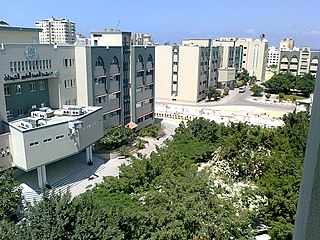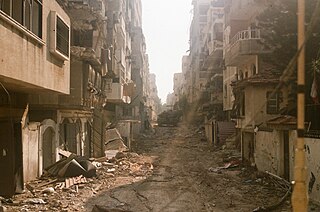
Gaza, also called Gaza City, is a Palestinian city in the Gaza Strip. Prior to the 2023 Israel–Hamas war, it was the most populous city in the State of Palestine, with 590,481 inhabitants in 2017.

Palestine, officially the State of Palestine, is a country in the southern Levant region of West Asia. It encompasses two disconnected territories — the West Bank and the Gaza Strip, collectively known as the Palestinian territories — within the larger region of Palestine. The country shares its borders with Israel to north, west and south, Jordan to the east and Egypt to the southwest. It has a combined land area of 6,020 square kilometres (2,320 sq mi) while its population exceeds five million people. Its proclaimed capital is Jerusalem while Ramallah serves as its administrative center and Rafah is currently its largest city. Arabic is the official language. The majority of Palestinians practice Islam while Christianity also has a significant presence.

The Gaza Strip smuggling tunnels are smuggling tunnels that had been dug under the Philadelphi Route along the Egypt–Gaza border. They were dug to subvert the blockade of the Gaza Strip to smuggle in fuel, food, weapons and other goods into the Gaza Strip. After the Egypt–Israel peace treaty of 1979, the town of Rafah, in the southern Gaza Strip, was split by this buffer zone. One part is located in the southern part of Gaza, and the smaller part of the town is in Egypt. After Israel withdrew from Gaza in 2005, the Philadelphi Corridor was placed under the control of the Palestine Authority until 2007, when Hamas seized power in 2007, and Egypt and Israel closed borders with the Gaza Strip.

General elections were held for the first time in the Palestinian territories on 20 January 1996 to elect the President of the Palestinian National Authority (PNA) and members of the Palestinian Legislative Council (PLC), the legislative arm of the PNA. They took place in the West Bank, the Gaza Strip, and East Jerusalem. A new government was formed following the elections, headed by President Yasser Arafat.

Al-Aqsa University is a public university with campuses in Gaza City and Khan Younis, Palestine. Established in 1955 as a teachers' institute before later expanding its curriculum, it is the first and oldest public higher education institution in the Gaza Strip. It caters for some 26,000 students and has some 1400 employees, 300 of whom are lecturers and professors.

The Islamic University of Gaza, also known as IUG and IU Gaza, is an independent Palestinian university established in 1978 in Gaza City. It was the first higher education institution to be established in the Gaza Strip. The university has 11 faculties capable of awarding BA, BSc, MA, MSc, MD, PhD, diplomas and higher diplomas, in addition to 20 research centers and institutes and the affiliated Turkish-Palestinian Friendship Hospital.

Palestinian art is a term used to refer to paintings, posters, installation art and other visual media produced by Palestinian artists.

The Great Mosque of Gaza, also known as the Great Omari Mosque, was the largest and oldest mosque in the Gaza Strip, Palestine, located in Gaza City.
Omar Mukhtar Street is the main street of Gaza City, in the State of Palestine, running from Palestine Square to the Port of Gaza in the Rimal district, separating the Old City's al-Daraj and Zaytoun quarters. Gaza's hotel strip is a part of Omar Mukhtar Street and most of Gaza's most important buildings are located along the street. Built during World War I by Ottoman governor Jamal Pasha, the street was originally named after him. However, following the ouster of Ottoman forces from Palestine in 1917, Gaza's city council headed by Fahmi al-Husseini named the street after Omar Mukhtar, a Libyan revolutionary leader.

Rashad al-Shawwa was the Palestinian mayor of Gaza for eleven years from 1971 to 1982. Before becoming mayor he was an outgoing local activist in the city. He was known by Israelis and Palestinians as the pro-Jordanian "father figure" of the Gaza Strip. He is the father of artist Laila Shawwa.

The known history of Gaza spans 4,000 years. Gaza was ruled, destroyed and repopulated by various dynasties, empires, and peoples. Originally a Canaanite settlement, it came under the control of the ancient Egyptians for roughly 350 years before being conquered and becoming one of the Philistines' principal cities. Gaza became part of the Assyrian Empire around 730 BC. Alexander the Great besieged and captured the city in 332 BC. Most of the inhabitants were killed during the assault, and the city, which became a center for Hellenistic learning and philosophy, was resettled by nearby Bedouins. The area changed hands regularly between two Greek successor-kingdoms, the Seleucids of Syria and the Ptolemies of Egypt, until it was besieged and taken by the Hasmoneans in 96 BC.
Sheikh Radwan is a district of Gaza City located nearly 3 kilometers (1.9 mi) northwest of the city center. It borders al-Shati camp to the southwest, Rimal to the south, and Jabalia to the east. The Sheikh Radwan Cemetery is located in the district. It contains hundreds of graves for Palestinians killed in the Israeli–Palestinian conflict, including Hamas leaders Ahmed Yassin, Abdel Aziz al-Rantissi, and Said Siam.
Laila Shawa, was a Palestinian visual artist whose work has been described as a personal reflection concerning the politics of her country, particularly highlighting perceived injustices and persecution. She was one of the most prominent and prolific artists of the Arabic revolutionary contemporary art scene.
The Palestine Poster Project Archives (PPPA) was founded as a means of collecting and digitally displaying a wide variety of works in the Palestine poster genre. The Palestine poster genre is more than a century old and growing. The Palestine Poster Project Archives continues to expand as the largest online collection of such posters.

The Egypt–Palestine border, also called Egypt–Gaza border, is the 12-kilometre (7.5 mi) long border between Egypt and the Gaza Strip. There is a buffer zone along the border which is about 14 kilometres (8.7 mi) long.

Raghib al-Alami was the mayor of Gaza City between 1965 and 1970. He was appointed by the Egyptian government while the Gaza Strip was under Egyptian control. He served office when Israel occupied Gaza during the 1967 Six-Day War with Egypt.

Rawya Rashad Said al-Shawa was a Palestinian journalist and politician. She was one of the first group of women elected to the Legislative Council in 1996.

The Bank of Palestine, is a Palestinian multinational banking organization founded in Gaza in 1960. It is headquartered in Ramallah, West Bank and is the leading financial institution in Palestine, with a net worth of $6.5 billion USD.
The Central Archives of Gaza City was an archive and study centre in Gaza, Palestine. Containing 150 years of archival material relating to Palestinian life and culture, the centre was destroyed in late November 2023 during the Israel–Hamas war.

The destruction of cultural heritage during the 2023 Israeli invasion of Gaza has invoiced the damage and destruction by Israel of hundreds of culturally or historically significant buildings, libraries, museums and other repositories of knowledge in Gaza, alongside the destruction of intangible cultural heritage. By late January 2024, more than half of the buildings in Gaza had been damaged or destroyed, leaving residential areas devastated and 1.7 million people displaced.















